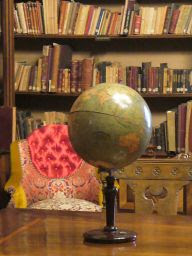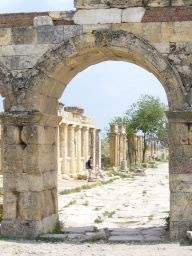

We booked a guided tour for our last full day in Istanbul. Much to our surprise we discovered that we had the tour to ourselves. Our guide, Serdar Ozkan, was brilliant – friendly, knowledgeable and low-key. Our time with him was definitely a highlight of our time in Turkey. Serdar took us on a fascinating tour of both the old and the new in Istanbul, uncovering a few surprises along the way. Look him up if you’re ever in Istanbul (
serdarozkan66@gmail.com).



Our first stop of the day was Suleymaniye Mosque. It was built by Koca Mimar Sinan for Suleyman the Magnificant. The lessons learnt here were later used to great effect at the even grander Blue Mosque. The main dome is 26 metres diameter, while the height above the floor is exactly double its diameter. The walls and ceiling are covered in striking red patterned tiles. Serdar pointed out the Ostrich eggs hanging from the lighting rigs. “They discourage spiders,” he explained but couldn’t explain why.

Outside sits a domed tomb containing the ceremonial coffins of Suleyman and his two successors – each draped in imperial green cloth. As with the mosque, the tombs walled are decorated in stunning ceramic tiles. Next door a similar tomb houses the coffin of Roxelana, Suleyman’s Russian wife.

Our next stop was equally awe inspiring. The Church of St Saviour in Chora contains some of the finest Byzantine mosaics still intact. The present building dates from the 11th Century. A relatively small structure, its ceilings and upper walls are covered in spectacular images of Christ, his genealogy and his ministry. The inner narthex contains 19 mosaics depicting the life of the Virgin.


However, the most novel image was that of Theodore Metochites, the artist responsible for restoring the present mosaics (between 1315-21). Above the door into the nave he can be seen humbly presenting a model of the church to Christ himself. We’d seen a similar image at Haghia Sophia. In this mosaic two of Constantinople’s greatest emperors offer similar models to an infant Christ in the arms of the Virgin. Constantine can be seen offering the city of Constantinople on her right, while Justinian offers a model of Haghia Sophia on her left.

From the Church of St Saviour in Chora, we were off across the Golden Horn to Beyoglu, considered the modern district of Istanbul. However, modern is a relative term in this city. Our first stop was Dolmabahce Palace, the final home of the last Ottoman Sultans. Built in 1856, it was designed to give Sultan Abdul Mecit a show home equal to that of the royal dynasties of Europe. This bold white building sits on the European shore of the Bosphorous with commanding views of old Istanbul’s dramatically minareted skyline.


Guided tours take you through the palace, the opulence of each room, surpassing the last. Perhaps the most spectacular room was the last on our tour. The Ceremonial Hall was awe inspiring. This stunning domed hall has room for 2500 people, its ceiling supported by rows of majestic pillars and its centre dominated by a truly enormous chandelier.

Our final stop of the day was Istiklal Caddesi. This pedestrian street snakes through the heart of Beyoglu. Each side is lined by late-19th Century European style apartment buildings and offices. An old red tram traverses the length of the street adding to its turn of the century charm. Everywhere we looked the crowd was overwhelming. It was easy to believe that Istanbul is home to more than 10.2 million people.


Serdar guided us effortlessly through several side streets, showing us the local fish market and a delightful café street where we stopped for a couple of welcome cold beers. From here we ventured on to Galata Tower for a series of stunning views over Istanbul, the Bosphorous and Galata Bridge.

The tower stands 60 metres, and is the most recognizable building on the Golden Horn. Its origins date back to the 6th Century when it was used to monitor shipping on the waterway below. Today, a restaurant and nightclub keep watch over the city below. The restaurant looked great but we didn't stop to eat. We'd already experienced a meal with a view the previous evening after dining at
Seven Hill Hotel. Nothing beats a meal at a rooftop table seven floors aboove stree level, midway between the Blue Mosque and the Haghia Sophia.

After a delicious seafood dinner in town we wandered back past the tower, now floodlight as darkness set in, and across Galata Bridge to our hotel. Much to our delight we discovered that the underside of the bridge is home to a promenade of bars, cafes and restaurants. Here you can sip on a cocktail while floodlit mosque shimmer across the waters of the Golden Horn. It seemed the ideal setting to reflect on our week in Turkey. This is a truly unique nation where history, religion and modern life live in surprising harmony. We’ll be back!
























































